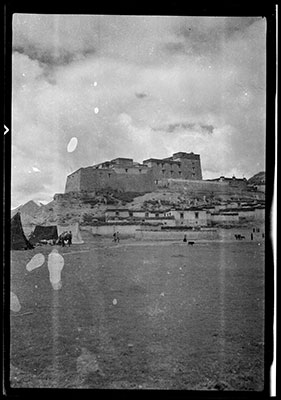
2001.59.3.25.1 (Film negative)


2001.59.3.25.1 (Film negative)

Hugh E. Richardson
Hugh Richardson
1936-38 or 1947-50
Yamdrok Tso Region > Nagartse
2001.59.3.25.1
85 X 56 mm
Negative film nitrate
Donated August 2001
The executors of the estate of Hugh E. Richardson
Hugh E. Richardson
Manual Catalogues - Notes on negative album - '3' 'MUG, LHOBRAG GORGE. GYANTSE. KHAMPA DANCERS. CHIPSHA MEN, CHOPA. APSOS DREPUNG. NORBULING. DEKYI. POTALA'
Manual Catalogues - Notes on negative index - 'Nangartse' (Sng dkar rtse)
Other Information - Location: Nangartse (snga dkar rtse) is situated on the route between Gyantse (rgyal rtse) and Lhasa north of the Yamdrok Tso (Yar 'brog mtsho) lake. The fortified building serve as the residence of the Dzongpon (rdzong dpon), the district governor, and as the adminstrative centre of the area. [TS 18/4/2005]
Other Information - Dates: This image is one of a group of nine images which have contact prints that have all been printed out using the same paper (Agfa Lupex) which is not generally found in Richardson’s collection. One of the images in this group contains an image of the Indian academic V. V. Gokhale who was in Lhasa in the late 1940s. However other images of this size printed out on Agfa Lupex, and which have decoratively cropped edges, can be dated to 1936-38 [MS 17/12/2005]
For Citation use:
The Tibet Album.
"Nagartse Dzong"
05 Dec. 2006. The Pitt Rivers Museum.
<http://tibet.prm.ox.ac.uk/photo_2001.59.3.25.1.html>.
For more information about photographic usage or to order prints, please visit the The Pitt Rivers Museum.
© The Pitt Rivers Museum